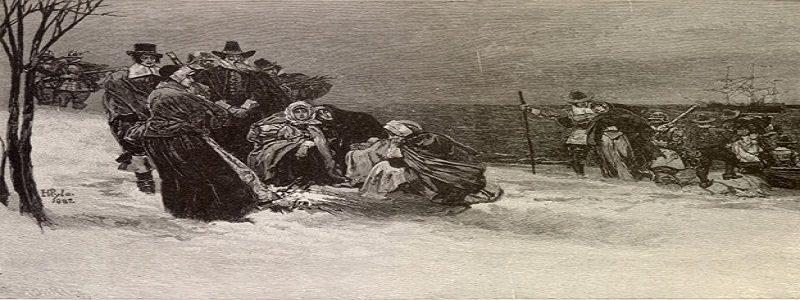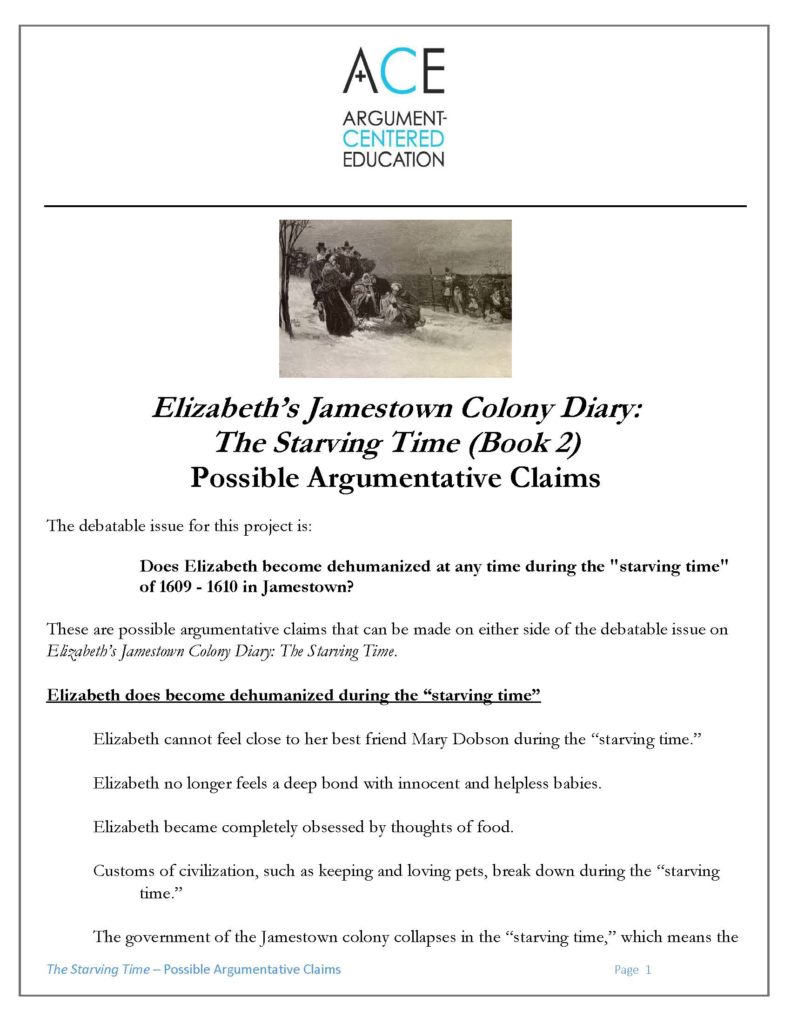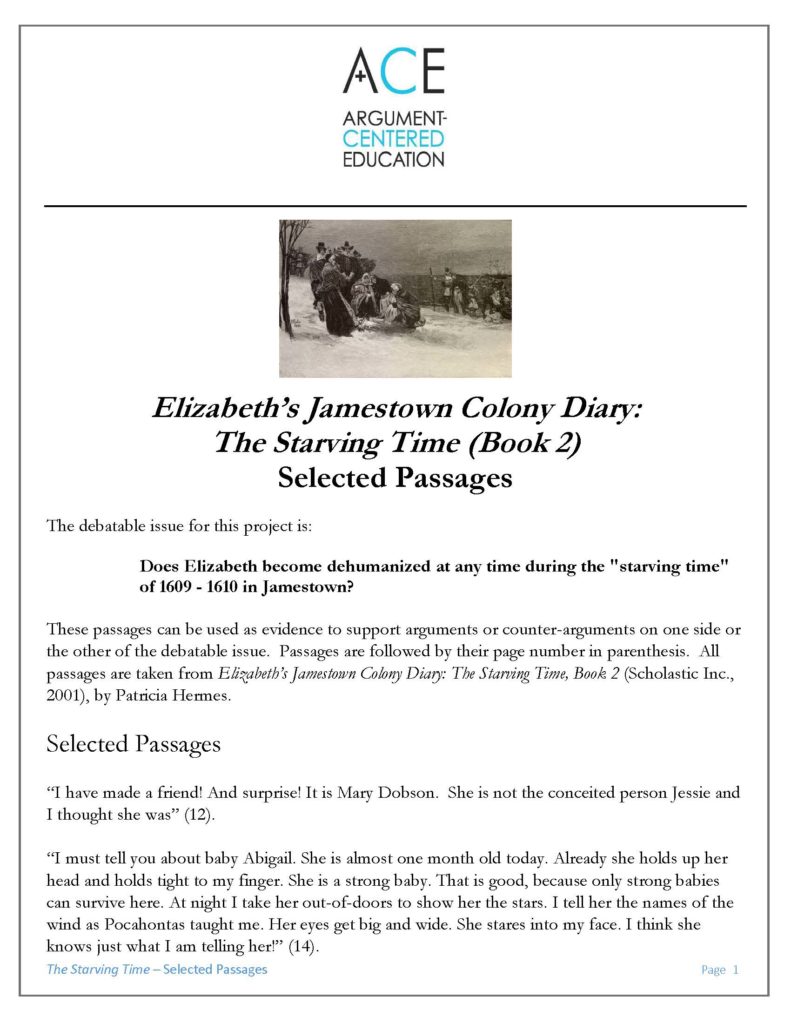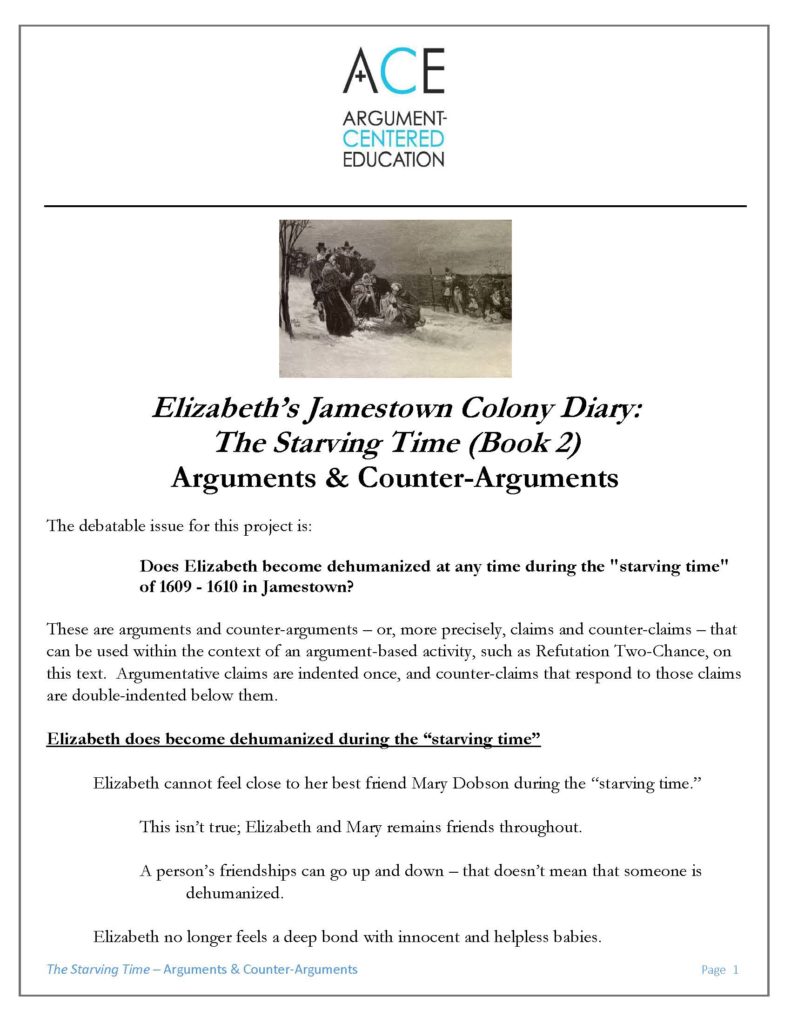
Building Them Up, Knocking Them Down: Argument and ‘Elizabeth’s Jamestown Diaries’
Overview
Patricia Hermes’ children’s historical fiction Elizabeth’s Jamestown Colony Diary: The Starving Time, Book 2 (Scholastic Inc., 2001) takes an up-close look at the original Jamestown colony settlement of the English London Company in what is now Virginia, in North America. The work is narrated by a precocious 9 year old girl named Elizabeth. She is drawn as a typical girl, if especially verbal, but she is witness to an extraordinary historical place and time.
The second book of this two-part fictionalized diary account of the Jamestown settlement, The Starving Time is set in 1609 – 1610, and focuses in particular on the awful winter in the middle of this period, during which a colony of nearly 500 people dwindled down, due to hunger and disease, to 60 stalwart survivors.
The Building Them Up, Knocking Them Down project has students assemble arguments from suggested argumentative claims and selected passages on the question over whether Elizabeth loses her essential humanity due to the brutally extreme conditions of that winter. Then it has students participate in Refutation Two-Chance, so that they can respond to counter-arguments from against the arguments they have built on the issue. The project ends with an optional argument writing assessment.
The debatable issue for this project is:
Does Elizabeth become dehumanized at any time during the “starving time” of 1609 – 1610 in Jamestown?
Method and Procedure
This activity should commence after the class has read Elizabeth’s Jamestown Colony Diary: The Starving Time. While reading the book, students should be asked questions about, and should discuss, diary entries in relation to the debatable issue: which side the entries support, what arguments they might be used to make, how they relate to other entries in the diary.
(1)
Begin by discussing the debatable issue. Make sure that all students understand what is meant by “dehumanization.” Use historical examples to create a set of definitional elements. Those might include:
Brutalization
Despair/depression
Loss of a will to live
Uncivilized behavior
(2)
Divide the class into two halves – one that is assigned to argue that Elizabeth does become dehumanized, and one that argues that she does not become dehumanized. You can find out from students what their initial thinking is on the issue, and assign them by preference. But you don’t have to do this, as students’ minds are likely to change through the course of the project.
Within each side, students should be paired up so that they can work with a partner.
(3)
Distribute the possible argumentative claims and discuss what each one means, how it might be supported, and how in turn it supports the overall position which it develops. You can add to this list of possible argumentative claims with ideas that the students generate, certainly.

(4)
Give each pair of students two argument builders and a copy of the Selected Passages. Pairs of students will choose two argumentative claims on their side of the issue and build the claims out into full arguments. They should try to find two pieces of evidence to support each argumentative claim, though some claims will only have one piece of evidence supporting them. Students can look through the text to find their own passages to support their claims. They can also formulate their own claim or claims – they are not restricted to the list of possible claims they are given.

(5)
Collect as a formative assessment the two argument builders and give students feedback on them. If there is time, have the students revise and re-submit their argument builders.
(6)
Now you are ready to conduct the Refutation Two-Chance Activity. Identify a student leader of each side. The leader is responsible for ensuring that their group is productive in preparing for the activity, and for naming which student from their group will be the next to speak.
(7)
The leaders should review the arguments that their side has built. They should choose four and announce the four argumentative claims that they have chosen to the other side.
(8)
Each side should then get Counter-Argument Builders that they should work on to respond to the other side’s arguments. You can, if you wish, distribute the Arguments and Counter-Arguments document that has recommended counter-claims against the list of possible argumentative claims. Or you can use a couple of those counter-arguments as models to work though with the class as a whole, before they are to work on their own counter-argument building.

(9)
Explain that this activity will hone and practice the ability to critique and respond to arguments, and to refute counter-arguments. Then model counter-argument and refutation of the counter-argument with the following example.
Debatable Issue: Is France’s ban on wearing the naqib a form of religious intolerance?
Position: France’s ban on wearing the naqib is oppressive to Islamic women.
Argument: Religious Muslim women in France are unable to work, hurting their families. According to the Guardian article (September 19, 2011), a Muslim woman, Hind Ahmas, has not looked for a job, even though she really needs one, because she cannot wear the naqib in public. Ms. Ahmas appears to be a typical Muslim woman, and her family is shown to be suffering hardships because she cannot work.
Counter-Argument: They say that the French ban on the naqib means that Muslim women are unable to work. But Muslim women like Hind Ahmas always have the option of removing their naqib while they are working. She shouldn’t feel oppressed because she can wear the naqib at home.
Refutation: They say that Muslim women have the option of taking off the naqib in public. But Muslim women won’t do this because they believe it violates their religion. The example of Ms. Ahmas is clear about that. So the French ban on the naqib in public still has the effect of preventing Muslim women from working, causing many Muslim families to be poor.
(10)
Begin the Refutation Two-Chance activity.
- Pick one of the sides to start.
- That side should state one of its arguments. To do so, a student should stand and deliver her argument, and stay standing.
- The other side should then make a counter-argument to respond to the argument. To do so, a student should stand and deliver his counter-argument, and stay standing.
- Then the first side should try to refute the counter-argument. They will have two chances to do so, by two students. The first student should stand and deliver her refutation. If she doesn’t effectively refute the counter-argument, she stays standing and a second student can try. If the second chance fails, the counter-argument side wins this round.
- The instructor should adjudicate as well as manage the process. The first team should receive two points if the first student refutes the counter-argument, one point if the second student does. The counter-argument side gets a point if the two chances at refutation fail.
- Adjudication should be based on Argument-Centered Education criteria for refutation: responsiveness, comprehensiveness, depth of thinking, and strength of counter-argument. See the ACE assessment rubric for more detail on these terms.
- Every student on a side should speak before any student speaks twice.
- When delivering a counter-argument and refutation of a counter-argument, students should use the “refutation construct,” which means referring to the other side’s point (“The other side said . . . .”) before responding (“But we disagree. . . . “).
- Arguments, counter-arguments, and refutation should not be repetitive. Each contribution should contain something not spoken entirely already.
(11)
Keep score. The activity ends when both sides have run out of new arguments. Then analyze the “glow” and “grow” highlights from the activity. You can conclude the project by giving students a short argument writing assessment in which they can choose their position, make two arguments to support it, and refute two counter-arguments.


